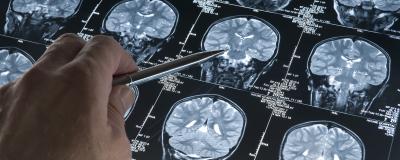A male patient in his 30s experienced two syncopal episodes associated with tunneled vision in 2017 and 2019 that had an unclear etiology. He was in otherwise excellent health, performing vigorous cardiovascular exercises three times per week.
Although the patient was vaccinated and boosted, he experienced mild symptoms from a COVID-19 infection in February 2022.
Presentation and examination
In early March 2022, he was evaluated in an outside hospital’s emergency department (ED) for acute onset of non-fluent aphasia and dysarthria. He had challenges with communication, e.g., finding the right words, difficulty constructing sentences and, eventually, slurring his words.
His head CT scan and EKG were unremarkable. He was discharged from the ED and advised to take aspirin and schedule a follow-up appointment with a neurologist.
Within a week of the onset of symptoms, the patient noted an improvement in his communication, but still had difficulty with speech. He was also unable to schedule an appointment with a vascular neurologist and was concerned that a full stroke workup had not been completed to evaluate his symptoms. As a result, he made an appointment at Rush.
The results from the magnetic resonance imaging of the brain indicated the patient had a small subacute infarct in the left thalamus. Magnetic resonance angiography showed that the vessels were open and that no atherosclerosis was present. Echocardiographic studies exhibited a patent foramen ovale (PFO) with a right-to-left shunt, along with moderate aortic regurgitation and a bicuspid aortic valve.
Treatment
It was thought that the etiology of the ischemic stroke is paradoxical embolism from the right to left cardiac shunt, with possible hypercoagulability in the setting of recent COVID-19 infection.
The PFO was closed by Dr. Kavinsky with the NobleStitch EL device in June 2022.
Outcome
After the successful PFO closure, the patient was able to resume all of his normal physical activities. He continued on aspirin for secondary stroke prevention.
He was also seen in Rush’s Stroke Prevention Clinic to educate him about additional ways to increase secondary stroke prevention, such as dietary modification.
Analysis
Although the outside hospital had concerns about a stroke during the initial evaluation, a comprehensive evaluation was not performed to pinpoint the cause of the patient’s symptoms, mainly because he was young and healthy. It is important to recognize that stroke can occur at
any age and practitioners evaluating symptoms such as those of this patient must remain vigilant to determine the root cause of the problem. In addition, while it is still early, COVID-19 has also been associated with an increased risk of stroke, especially among the young.
While a bicuspid aortic valve is rarely associated with cerebral embolism in the absence of endocarditis, it is not unusual for microthrombus formation and valvular thickening with incompetence to eventuate in embolization. The patient’s right-to-left cardiac shunt may also have led to a paradoxical embolism.
Rising rates of ischemic stroke in the young and middle-aged adults
While only about 10 to 15% of ischemic strokes occur in patients between the ages of 18 and 50, the incidence of stroke in this population is increasing. A 2010-16 study found that patients between 35 and 64 years of age had a three-fold increase in the number of deaths from stroke, compared to the over-65 population. Specifically, the incidence of stroke for U.S. adults between ages 20 and 44 increased from 17 per 100,000 U.S. adults in 1993 to 28 per 100,000 in 2015.
Adults have a great number of risk factors that can lead to stroke, including cardiovascular comorbidities (i.e., hypertension, diabetes and obesity) and lifestyle behaviors (i.e., substance abuse, physical inactivity and poor diet).
Different conditions can result in stroke in young adults, including PFO, arterial dissection, hematological conditions, inherited conditions, vasculitis, pregnancy and migraines, among others.
Over the past decade, we have seen a rise in the rate of stroke incidence in young adults — with multiple reasons that are mainly attributed to lifestyle changes, including an increase in diabetes, hypercholesterolemia and obesity, as well as the more frequent use of alcohol, illicit substances and cigarettes. Another reason for the rise in stroke incidence in young adults is increased awareness of the signs and symptoms of stroke and earlier identification of stroke cases by treating physicians.
Stroke and secondary stroke prevention
Lifestyle modifications, such as the cessation or reduction of tobacco and alcohol, increased physical activity and a healthy diet, are accessible ways for young patients to reduce their risk of developing strokes and decrease the chance of their reoccurrence if they have already experienced one.
Obesity, by causing several other comorbidities such as hypertension, diabetes and high cholesterol, is a major factor in stroke occurrence and therefore should be addressed.

